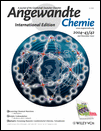Directing Self-Assembly of Nanoparticles at Water/Oil Interfaces†
Hongwei Duan
Max Planck Institute of Colloids and Interfaces, 14424 Potsdam, Germany, Fax: (+49) 331-5679202
Search for more papers by this authorDayang Wang Dr.
Max Planck Institute of Colloids and Interfaces, 14424 Potsdam, Germany, Fax: (+49) 331-5679202
Search for more papers by this authorDirk G. Kurth Dr.
Max Planck Institute of Colloids and Interfaces, 14424 Potsdam, Germany, Fax: (+49) 331-5679202
Search for more papers by this authorHelmuth Möhwald Prof.
Max Planck Institute of Colloids and Interfaces, 14424 Potsdam, Germany, Fax: (+49) 331-5679202
Search for more papers by this authorHongwei Duan
Max Planck Institute of Colloids and Interfaces, 14424 Potsdam, Germany, Fax: (+49) 331-5679202
Search for more papers by this authorDayang Wang Dr.
Max Planck Institute of Colloids and Interfaces, 14424 Potsdam, Germany, Fax: (+49) 331-5679202
Search for more papers by this authorDirk G. Kurth Dr.
Max Planck Institute of Colloids and Interfaces, 14424 Potsdam, Germany, Fax: (+49) 331-5679202
Search for more papers by this authorHelmuth Möhwald Prof.
Max Planck Institute of Colloids and Interfaces, 14424 Potsdam, Germany, Fax: (+49) 331-5679202
Search for more papers by this authorThis work is supported by the Max Planck Society. We thank J. Hartmann and R. Pitschke for assistance with the TEM measurements.
Graphical Abstract
Finding the right angle: The contact angle of nanoparticles at the water/oil interface can be engineered close to 90° by capping with ligands containing carboxylic ester terminal groups. This drives the nanoparticles to self-assemble into close-packed films (see picture), and thus provides the opportunity to create two- or three-dimensional homo- or heterogeneous nanostructures for electronic, optoelectrical, and magnetic applications.
References
- 1
- 1aH. Weller, Angew. Chem. 1993, 105, 43–55; Angew. Chem. Int. Ed. Engl. 1993, 32, 41–53; ;
- 1bA. P. Alivisatos, Science 1996, 271, 933–937.
- 2
- 2aC. P. Collier, T. Vossmeyer, J. R. Heath, Annu. Rev. Phys. Chem. 1998, 49, 371–404;
- 2bC. B. Murray, C. R. Kagan, M. G. Bawendi, Annu. Rev. Mater. Sci. 2000, 30, 545–610.
- 3
- 3aM. D. Musick, C. D. Keating, M. H. Keefe, M. J. Natan, Chem. Mater. 1997, 9, 1499–1501;
- 3bC. M. Niemeyer, Angew. Chem. 2001, 113, 4254–4287;
10.1002/1521-3757(20011119)113:22<4254::AID-ANGE4254>3.0.CO;2-D Google ScholarAngew. Chem. Int. Ed. 2001, 40, 4128–4158;10.1002/1521-3773(20011119)40:22<4128::AID-ANIE4128>3.0.CO;2-S CAS PubMed Web of Science® Google Scholar
- 3cP. M. Mendes, Y. Chen, R. E. Palmer, K. Nikitin, D. Fitzmaurice, J. A. Preece, J. Phys. Condens. Matter 2003, 15, S 3047-S3063;
- 3dR. Shenhar, V. M. Rotello, Acc. Chem. Res. 2003, 36, 549–561.
- 4
- 4aC. J. Kiely, J. Fink, J. G. Zheng, M. Brust, D. Bethell, D. J. Schiffrin, Adv. Mater. 2000, 12, 640–643;
- 4bE. V. Shevchenko, D. V. Talapin, A. L. Rogach, A. Kornowski, M. Haase, H. Weller, J. Am. Chem. Soc. 2002, 124, 11 480–11 485;
- 4cF. X. Redl, K. S. Cho, C. B. Murray, S. O'Brien, Nature 2003, 423, 968–971.
- 5
- 5aJ. H. Fendler, Curr. Opin. Colloid Interface Sci. 1996, 1, 202–207;
- 5bB. Kim, S. L. Tripp, A. Wei, J. Am. Chem. Soc. 2001, 123, 7955–7956.
- 6
- 6aD. Yogev, S. Efrima, J. Phys. Chem. 1988, 92, 5754–5760;
- 6bC. N. R. Rao, G. U. Kulkarni, P. J. Thomas, V. V. Agrawal, P. Saravanan, J. Phys. Chem. B 2003, 107, 7391–7395.
- 7aY. Lin, H. Skaff, T. Emrick, A. D. Dinsmore, T. P. Russell, Science 2003, 299, 226–229;
- 7bF. Reincke, S. G. Hickey, W. K. Kegel, D. Vanmaekelbergh, Angew. Chem. 2004, 116, 464–468;
10.1002/ange.200352339 Google ScholarAngew. Chem. Int. Ed. 2004, 43, 458–462.
- 8For recent reviews, see:
- 8aB. P. Binks, Curr. Opin. Colloid Interface Sci. 2002, 7, 21–41;
- 8bR. Aveyard, B. P. Binks, J. H. Clint, Adv. Colloid Interface Sci. 2003, 100–102, 503–546.
- 9
- 9aS. Chen, H. Yao, K. Kimura, Langmuir 2001, 17, 733–739;
- 9bK. S. Mayya, M. Sastry, Langmuir 1999, 15, 1902–1904.
- 10 Contact angle, wettability and adhesion (Ed.: ), VSP BV, Utrecht, 1993.
- 11
- 11aS. Nuß, H. Böttcher, H. Wurm, M. L. Hallensleben, Angew. Chem. 2001, 113, 4137–4139;
10.1002/1521-3757(20011105)113:21<4137::AID-ANGE4137>3.0.CO;2-J Google ScholarAngew. Chem. Int. Ed. 2001, 40, 4016–4018;10.1002/1521-3773(20011105)40:21<4016::AID-ANIE4016>3.0.CO;2-J CAS PubMed Web of Science® Google Scholar
- 11bK. Ohno, K. Koh, Y. Tsujii, T. Fukuda, Angew. Chem. 2003, 115, 2857–2860;
10.1002/ange.200250850 Google ScholarAngew. Chem. Int. Ed. 2003, 42, 2751–2754;
- 11cY. Wang, X. Teng, J. Wang, H. Yang, Nano Lett. 2003, 3, 789–793;
- 11dT. K. Mandal, M. S. Fleming, D. R. Walt, Nano Lett. 2002, 2, 3–7.
- 12 Colloidal Gold: Principles, Methods, and Applications (Ed.: ), Academic Press, San Diego, CA, 1991.
- 13P. Mulvaney, Langmuir 1996, 12, 788–800.
- 14W. Wang, S. Efrima, O. Regev, J. Phys. Chem. B 1999, 103, 5613–5621.
- 15S. Sun, H. Zeng, J. Am. Chem. Soc. 2002, 124, 8204–8205.
- 16R. R. Shah, D. Merreceyes, M. Husemann, I. Rees, N. L. Abbott, C. J. Hawker, J. L. Hedrick, Macromolecules 2000, 33, 597–605.





